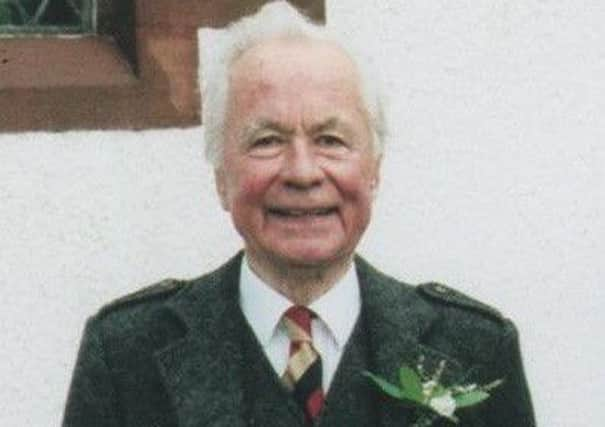Obituary: Adam Kennedy Bergius, DSC, Operation Sabre hero, submariner and sailor


Imperial Japan was no match for the 20-year-old Scotsman who in the summer of 1945 dived from a submerged X-craft midget submarine to cut her vital communication cable on the sea-bed.
Even as he drew on the pure oxygen of his closed-circuit breathing apparatus, which at a depth below 30 feet could fatally poison him, Sub Lieutenant Adam Bergius RNVR had in his veins the confidence born of a family background in Glasgow marine engineering and whisky-distilling.
Advertisement
Hide AdAdvertisement
Hide AdAt 55 feet down in the muddy Mekong Delta off Saigon on 31 July, he needed every drop, in order to sever, with a powered cutter, the bundle of thick copper wires. These carried enemy signals between the southern city of then-Japanese-occupied French Indo-China (now Ho Chi Minh City, Vietnam), and Japanese-occupied Hong Kong. He surfaced, triumphant, with a section of it.
The cable was one of two: the other linked Saigon to Singapore. It was disabled the same day by Bergius’s colleague, an Australian, Sub Lieutenant Ken Briggs. The X-craft detected the cables by dragging a grapnel along the sea-bed. Another X-craft, XE-5, attempted the same on Japanese cables at Hong Kong, but failed.
Bergius’ and Briggs’s daring mission, Operation Sabre, which won them both the Distinguished Service Cross, was the only way for the Allies to break Japanese secrecy: without the cable, Japanese military chiefs would be forced to exchange messages by radio – which the Allies could intercept.
Only that prize had persuaded US Navy chiefs fighting Japan in the Pacific to agree to the terrifying expeditions in the British craft .
X-craft XE-4, whose five-man crew led by Lieutenant Max Shean, DSO (later DSO and Bar), RANVR, had trained in Scotland at Loch Striven and Loch Cairnbawn, had been transported through the Panama Canal and on to Hawaii and Australia before being towed by the submarine HMS Spearhead the 650 miles from the depot-ship HMS Bonaventure in Brunei Bay off Borneo, to the target area where the cables lay.
The 53-ft long midget submarine, less than 6ft wide, was branded a “suicide craft” by US Fleet Admiral Chester W Nimitz, and its use ruled out, until the need to intercept Japanese messages changed American minds, and Nimitz relented.
For the X-craft crews, the mission was the climax of a rigorous training regime that demanded immense self-control as well as courage. Bergius, finding that his powered cutter, stowed on the outside casing of the craft, did not work, took the precaution of re-entering the craft to breathe some air, then went through the uncomfortable re-entry into the water, through a tiny watertight chamber, to try again with another tool. He had 20 minutes before the closed oxygen system, used to avoid bubbles giving a diver’s position away, would imperil his brain and his body’s metabolism. This time the cutter succeeded.
Six days later came the news of the dropping of the atomic bomb on Hiroshima on 6 August, 1945.
Advertisement
Hide AdAdvertisement
Hide AdAfter Japan’s surrender and the war’s end, Bergius became navigator of HMS Spearhead, taking her back to Portsmouth. He later commanded a naval tug.
He had put himself forward for “special and hazardous duties” after enlisting in the Royal Naval Volunteer Reserve in November 1943, straight from school at Glenalmond.
Two months before he joined, British X-craft had in September 1943 disabled the German battleship Tirpitz in Asenfjord, Norway.
Bergius had been a sailor since childhood. The family always had a boat, and his father William Bergius pioneered the fitting of engines to fishing vessels – the engines being adapted versions of the car engines designed by William’s brother, Walter Bergius, founder of the Bergius Car and Engine Company in Glasgow.
The brothers’ father, Walter Karl Bergius, a civil engineer, had come to Glasgow from Germany in the 1880s, and there married Agnes, a daughter of the Teachers whisky family.
Adam, the youngest of William’s five children, was so skilled a swimmer that he could dive through a four-foot wide submerged rock arch in the river Massan near their holiday home at Kirn, near Dunoon, in Argyll.
He had gone on to Glenalmond after schooling at Kelvinside Academy, Glasgow. His destiny was, after his wartime adventures, to work for Teachers, the family whisky firm, for more than 30 years, succeeding his brother, Walter, as chairman.
He married, in 1952, Fiona Sillars. The couple met because of Bergius’s love of Bentley cars, which he shared with her two brothers. His own was a 1926 four-seater open-top in Brooklands racing green.
Advertisement
Hide AdAdvertisement
Hide AdAdam and Fiona, both keen sailors, would have five children: Charles, Cara, Peter, Johnny and Pol. Fiona died in 2011; their children survive him.
Adam Bergius became the first and, at 26, the youngest Commodore of Helensburgh Sailing Club, from 1951-3.
He wrote a light-hearted book, “Make Your Own Scotch Whisky” (1995), which advises enthusiasts to get a plumber to copy the shape of an onion in copper to hold the wash from fermentation.
Fellow mariners remember him as “a truly accomplished seat-of-the-pants navigator”, and at nearly 80 he took family members to St Kilda, enduring with amusement being upbraided, on landing, by a National Trust for Scotland official for not wearing a lifejacket.
ANNE KELENY